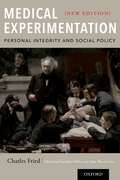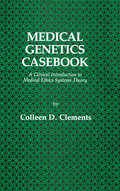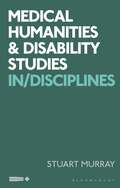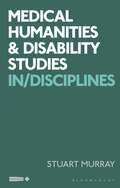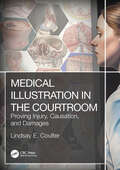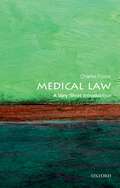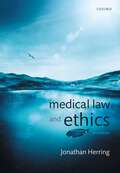- Table View
- List View
Medical Experimentation: Personal Integrity and Social Policy: New Edition
by Charles FriedFirst published in 1974, Charles Fried's Medical Experimentation is a classic statement of the moral relationship between doctor and patient, as expressed within the concept of personal care. This concept is then tested in the context of medical experimentation and, more specifically, the randomized controlled trial (RCT). Regularly referred to as a point of departure for ethical and legal discussions of the RCT, the book has long been out of print. This new, second edition includes a general introduction by Franklin Miller and the late Alan Wertheimer, a reprint of the 1974 text, and an in-depth analysis by Harvard Law School scholars I. Glenn Cohen and D. James Greiner which discusses the extension of RTCTs to social science and public policy contexts. The volume concludes with a new essay by Charles Fried that reflects on the original text and how it applies to the contemporary landscape of medicine and medical experimentation.
Medical Experimentation: Personal Integrity and Social Policy: New Edition
by Charles FriedFirst published in 1974, Charles Fried's Medical Experimentation is a classic statement of the moral relationship between doctor and patient, as expressed within the concept of personal care. This concept is then tested in the context of medical experimentation and, more specifically, the randomized controlled trial (RCT). Regularly referred to as a point of departure for ethical and legal discussions of the RCT, the book has long been out of print. This new, second edition includes a general introduction by Franklin Miller and the late Alan Wertheimer, a reprint of the 1974 text, and an in-depth analysis by Harvard Law School scholars I. Glenn Cohen and D. James Greiner which discusses the extension of RTCTs to social science and public policy contexts. The volume concludes with a new essay by Charles Fried that reflects on the original text and how it applies to the contemporary landscape of medicine and medical experimentation.
Medical Genetics Casebook: A Clinical Introduction to Medical Ethics Systems Theory (Contemporary Issues in Biomedicine, Ethics, and Society)
by Colleen D. ClementsThe Direction of Medical Ethics The direction bioethics, and specifically medical ethics, will take in the next few years will be crucial. It is an emerging specialty that has attempted a great deal, that has many differing agendas, and that has its own identity crisis. Is it a subspecialty of clinical medicine? Is it a medical reform movement? Is it a consumer pro tection movement? Is it a branch of professional ethics? Is it a ra tionale for legal decisions and agency regulations? Is it something physicians and ethical theorists do constructively together? Or is it a morally concentrated attack on high technology, with the prac titioners of scientific medicine and the medical ethicists in an adversarial role? Is it a conservative endeavor, exhibiting a Frankenstein syn drome in Medical Genetics ("this time, they have gone too far"), or a Clockwork Orange syndrome in Psychotherapy ("we have met hods to make you talk-walk-cry-kill")? Or does it suffer the afflic tion of overdependency on the informal fallacy of the Slippery Slope ("one step down this hill and we will never be able to stop") that remains an informal fallacy no matter how frequently it's used? Is it a restricted endeavor of analytic philosophy: what is the meaning of "disease," how is "justice" used in the allocation of medical resources, what constitutes "informed" or "consent?" Is it applied ethics, leading in clinical practice to some recommenda tion for therapeutic or preventive action? This incomplete list of questions indicates just how complex,
Medical Humanities and Disability Studies: In/Disciplines (Critical Interventions in the Medical and Health Humanities)
by Stuart MurrayMedical humanities and disability studies are disciplines at the cutting edge of innovative critical work in the study of health and disability, but to date there has been no book-length examination of the relationship between the two. Although each has emerged from different heritages, they share many features, from discussing the complexities of embodiment, identifying processes of exclusion and championing user participation, to a commitment to new forms of critical writing. In/Disciplines explores the connections between the two disciplines in detail. It presents a series of provocations about how they interact, the forms their practice take, and their strengths and weaknesses as working methods. With a focus on life stories that give accounts of health and disability experiences, it mixes creative and critical writing in an accessible manner aimed at a wide audience in both Medical Humanities and Disability Studies, and across new humanities more widely. The book asserts that both disciplines need to evaluate and challenge core assumptions if they are to remain critically relevant in the evolving study of social and cultural understanding of health and disability.
Medical Humanities and Disability Studies: In/Disciplines (Critical Interventions in the Medical and Health Humanities)
by Stuart MurrayMedical humanities and disability studies are disciplines at the cutting edge of innovative critical work in the study of health and disability, but to date there has been no book-length examination of the relationship between the two. Although each has emerged from different heritages, they share many features, from discussing the complexities of embodiment, identifying processes of exclusion and championing user participation, to a commitment to new forms of critical writing. In/Disciplines explores the connections between the two disciplines in detail. It presents a series of provocations about how they interact, the forms their practice take, and their strengths and weaknesses as working methods. With a focus on life stories that give accounts of health and disability experiences, it mixes creative and critical writing in an accessible manner aimed at a wide audience in both Medical Humanities and Disability Studies, and across new humanities more widely. The book asserts that both disciplines need to evaluate and challenge core assumptions if they are to remain critically relevant in the evolving study of social and cultural understanding of health and disability.
Medical Illustration in the Courtroom: Proving Injury, Causation, and Damages
by Lindsay E. CoulterMedical Illustration in the Courtroom: Proving Injury, Causation, and Damages educates the reader on how to communicate science visually—in personal injury, medical malpractice, criminal, and forensic cases—by creating art that utilizes medical records, radiographs, and computer software. Medical illustration bridges the gap between complex technical, medical, and scientific concepts to clearly illustrate, and explain visually, a medical condition, negligence, or the causation of an injury or death to the lay person. Medical artists are frequently challenged with illustrating injuries and medical conditions that can’t be seen by the naked eye. And while using medical photography and imaging for illustrative purposes can be helpful, to an untrained eye it can often be unclear or confusing. This is where the medical illustrator enters the equation. There are often patients who have recovered from an injury or infection that appear in good health. However, should an unforeseen injury or fatality happen, medical illustrators can reveal to people what’s actually going on inside the person, an invaluable asset to attorneys in the courtroom—especially for personal injury and medical malpractice cases. While many attorneys utilize medical artists, nonvisual people don’t always recognize the value of demonstrative aids until they see them first-hand.When attorneys and their clients enlist the aid of medical artists, it quickly becomes apparent that properly conceived and executed artwork is invaluable to illustrating the facts—and medical impacts—of any number of scenarios: homicides by shooting, stabbings, vehicular accidents, in addition to medical malpractice and personal injuries resulting from surgery or possible negligence.Presenting a myriad of services and computer technologies that can be utilized, Medical Illustration in the Courtroom provides demonstrative aids used in cases to illustrate personal injury and medical malpractice, employing "tricks of the trade" to create an accurate effective image. Such images are educational to attorneys, insurance adjusters, judges, and juries to help create a visual storyline, the goal being to help combine art and science to provide a clear illustration of events to help in adjudicate legal and forensic cases.
Medical Illustration in the Courtroom: Proving Injury, Causation, and Damages
by Lindsay E. CoulterMedical Illustration in the Courtroom: Proving Injury, Causation, and Damages educates the reader on how to communicate science visually—in personal injury, medical malpractice, criminal, and forensic cases—by creating art that utilizes medical records, radiographs, and computer software. Medical illustration bridges the gap between complex technical, medical, and scientific concepts to clearly illustrate, and explain visually, a medical condition, negligence, or the causation of an injury or death to the lay person. Medical artists are frequently challenged with illustrating injuries and medical conditions that can’t be seen by the naked eye. And while using medical photography and imaging for illustrative purposes can be helpful, to an untrained eye it can often be unclear or confusing. This is where the medical illustrator enters the equation. There are often patients who have recovered from an injury or infection that appear in good health. However, should an unforeseen injury or fatality happen, medical illustrators can reveal to people what’s actually going on inside the person, an invaluable asset to attorneys in the courtroom—especially for personal injury and medical malpractice cases. While many attorneys utilize medical artists, nonvisual people don’t always recognize the value of demonstrative aids until they see them first-hand.When attorneys and their clients enlist the aid of medical artists, it quickly becomes apparent that properly conceived and executed artwork is invaluable to illustrating the facts—and medical impacts—of any number of scenarios: homicides by shooting, stabbings, vehicular accidents, in addition to medical malpractice and personal injuries resulting from surgery or possible negligence.Presenting a myriad of services and computer technologies that can be utilized, Medical Illustration in the Courtroom provides demonstrative aids used in cases to illustrate personal injury and medical malpractice, employing "tricks of the trade" to create an accurate effective image. Such images are educational to attorneys, insurance adjusters, judges, and juries to help create a visual storyline, the goal being to help combine art and science to provide a clear illustration of events to help in adjudicate legal and forensic cases.
Medical Jurisprudence and Rules of the Medical Profession: The Nazi Viewpoint On The Position And Responsibilities Of The Physician In The German National Socialist Society (Philosophy and Medicine #135)
by Rudolf RammThe Nazi Viewpoint on the Position and Responsibilities of the Physician in the German National Socialist Society. This work is translated, annotated and introduced by Melvin Wayne Cooper. This is the first translation in English of Rudolf Ramm’s textbook Ärztliche Rechts- und Standeskunde: Der Arzt als Gesundheitserzieher, translated and introduced by Melvin Wayne Cooper. Medical Jurisprudence and Rules of the Medical Profession has been reported to be an influential manual for medical ethics in Nazi Germany and is commonly quoted as representing the Nazi viewpoint of the position and responsibilities of the physician in the National Socialist society. It interprets the National Socialist Weltanschauung, i.e. the National Socialist Philosophical Worldview, and makes explicit how this world view was to be actuated by the true National Socialist physician. It is a good text to attempt to see the National Socialist medical world view from the perspective of its practitioners. Ramm’s text could be viewed as being analogous to an Army Field Manual for the practicing National Socialist physician. It dictates the specific applications of the legal values and rules which emanate from this Weltanschauung to the developing medical students and practicing National Socialist physicians. According to some scholars Ramm’s book, which was written not only for students but also for postgraduates, and which received positive reviews in German medical journals, is the most important known historical source pertaining to the instruction of Nazi medical ethics. The 1942 edition sold out within a year, and a second edition published in 1943 included an extended appendix of medical laws. Through this book Ramm’s unique text is now available for an English language audience, thanks to the thorough translation and accessible introduction by Melvin Wayne Cooper.
Medical Jurisprudence & Clinical Forensic Medicine: An Indian Perspective
by Dr Ambika Prasad Patra And Dr Kusa Kumar Shaha Md Frcp Ffflm Mba Professor (additional) & Head of Department Faculty Of Medicine Department of Forensic Medicine & Toxicology Jawaharlal Institute of Post-graduate Medical Education & Research India; Member of International Academy of Legal Medicine of Switzerland; Faculty member (by equivalent qualification) of Forensic & Legal Medicine of London; Member of Indian Academy of Forensic Medicine & Indian Society of Toxicology (ex-officio). Dr Kusa Kumar Shaha MbbsThis book on Medical Jurisprudence & Clinical Forensic Medicine addresses the evolving nature of law and medicine. It updates the medicolegal (ML) systems and discusses the concerns related to digitalization of courts, serving a subpoena through social media, ethical/ML issues in nanomedicine, telemedicine and online prescription practices, toxicology and mass disaster. It fulfils the increased demands of students, forensic medicine specialists, clinicians and lawyers to get authentic medicolegal information in situations of ethical dilemma or during ML urgencies. It features case-based discussions on ML and deontological issues supported by the latest legal/statutory information. Key Features:• Discusses the clinical and applied aspects of forensic medicine through illustrative case scenarios and reports.• Addresses the needs of clinicians and forensic medicine specialists in writing medico-legal reports for specific cases.• Provides evidence-based solutions to medicolegal and ethical dilemma faced during routine practice.
Medical Jurisprudence & Clinical Forensic Medicine: An Indian Perspective
This book on Medical Jurisprudence & Clinical Forensic Medicine addresses the evolving nature of law and medicine. It updates the medicolegal (ML) systems and discusses the concerns related to digitalization of courts, serving a subpoena through social media, ethical/ML issues in nanomedicine, telemedicine and online prescription practices, toxicology and mass disaster. It fulfils the increased demands of students, forensic medicine specialists, clinicians and lawyers to get authentic medicolegal information in situations of ethical dilemma or during ML urgencies. It features case-based discussions on ML and deontological issues supported by the latest legal/statutory information. Key Features:• Discusses the clinical and applied aspects of forensic medicine through illustrative case scenarios and reports.• Addresses the needs of clinicians and forensic medicine specialists in writing medico-legal reports for specific cases.• Provides evidence-based solutions to medicolegal and ethical dilemma faced during routine practice.
Medical Law (Very Short Introductions Ser.)
by Charles FosterMedical law is concerned with our bodies, and what happens to them during and after our lives. When things go wrong with our bodies, we want to know what our rights are, and what governs the conduct of the clinicians into whose hands we put our lives and limbs. Dealing with matters of life and death, it can therefore have a fundamental impact on medical practice. Headlines in the media often involve the core issues of medical law - organ transplantation, abortion, withdrawal of treatment, euthanasia, confidentiality, research on humans - these are topics that affect us all. Headlines can misrepresent, however. In order to fully understand the issues and their relevance, we have to delve into the cases and into the principles behind them. In this highly readable Very Short Introduction, Charles Foster explores different examples to illustrate the key problems and principles of medical law. ABOUT THE SERIES: The Very Short Introductions series from Oxford University Press contains hundreds of titles in almost every subject area. These pocket-sized books are the perfect way to get ahead in a new subject quickly. Our expert authors combine facts, analysis, perspective, new ideas, and enthusiasm to make interesting and challenging topics highly readable.
Medical Law: Text, Cases, And Materials (PDF) (Text,cases And Materials Ser.)
by Emily JacksonMedical Law: Text, Cases, and Materials offers all of the explanation, commentary, and extracts from cases and key materials that students need to gain a thorough understanding of this complex topic. Key case extracts provide the legal context, facts, and background; extracts from materials provide differing ethical perspectives and outline current debates; and the author's insightful commentary ensures that readers understand the facts of the cases and can navigate the ethical landscape to form their own understanding of medical law.
Medical Law: Text, Cases, and Materials (Text, Cases, and Materials)
by Emily JacksonMedical Law: Text, Cases, and Materials offers all of the explanation, commentary, and extracts from cases and key materials that students need to gain a thorough understanding of this complex topic. Key case extracts provide the legal context, facts, and background; extracts from materials provide differing ethical perspectives and outline current debates; and the author's insightful commentary ensures that readers understand the facts of the cases and can navigate the ethical landscape to form their own understanding of medical law. Digital formats This sixth edition is available for students and institutions to purchase in a variety of formats. The e-book offers a mobile experience and convenient access along with functionality tools, navigation features, and links that offer extra learning support: www.oxfordtextbooks.co.uk/ebooks
Medical Law: Text, Cases, and Materials (Text, Cases, and Materials)
by Emily JacksonMedical Law: Text, Cases, and Materials offers all of the explanation, commentary, and extracts from cases and key materials that students need to gain a thorough understanding of this complex topic. Key case extracts provide the legal context, facts, and background; extracts from materials provide differing ethical perspectives and outline current debates; and the author's insightful commentary ensures that readers understand the facts of the cases and can navigate the ethical landscape to form their own understanding of medical law. Digital formats This sixth edition is available for students and institutions to purchase in a variety of formats. The e-book offers a mobile experience and convenient access along with functionality tools, navigation features, and links that offer extra learning support: www.oxfordtextbooks.co.uk/ebooks
Medical Law: Law Revision And Study Guide (Macmillan Law Masters)
by Ash Samanta Jo SamantaThe second edition of a major text provides a thorough exploration of medical law and ethics, written from the perspective of authors who are medical and health care practitioners as well as law lecturers. This unique combination of academic knowledge and professional experience provides a unique perspective through which the subject is examined with academic rigour underpinned by practical insights.The text features an innovative series of scenarios threaded through each chapter to illustrate the practical realities behind the rules and concepts discussed. The format also includes mind maps, key terms, end of chapter summaries, self-test exercises and suggestions for further reading.
Medical Law (Macmillan Law Masters)
by Jo Samanta Ash SamantaThe second edition of a major text provides a thorough exploration of medical law and ethics, written from the perspective of authors who are medical and health care practitioners as well as law lecturers. This unique combination of academic knowledge and professional experience provides a unique perspective through which the subject is examined with academic rigour underpinned by practical insights.The text features an innovative series of scenarios threaded through each chapter to illustrate the practical realities behind the rules and concepts discussed. The format also includes mind maps, key terms, end of chapter summaries, self-test exercises and suggestions for further reading.
Medical Law and Ethics (Great Debates In Law Ser.)
by Jonathan HerringMedical Law and Ethics covers the core legal principles, key cases, and statutes that govern medical law alongside the key ethical debates and dilemmas that exist in the field. Carefully constructed features highlight these debates, drawing out the European angles, religious beliefs, and feminist perspectives which influence legal regulations. Other features such as 'a shock to the system', 'public opinion' and 'reality check' introduce further socio-legal discussion and contribute to the lively and engaging manner in which the subject is approached. Digital formats and resources The ninth edition is available for students and institutions to purchase in a variety of formats, and is supported by online resources. · The e-book offers a mobile experience and convenient access along with functionality tools, navigation features and links that offer extra learning support: www.oxfordtextbooks.co.uk/ebooks · The online resources include: complete bibliography and list of further reading; links to key cases; a video from the author which introduces the book; links to key sites with information on medical law and ethics; and answer guidance to one question per chapter.
Medical Law and Ethics
by Jonathan HerringMedical Law and Ethics covers the core legal principles, key cases, and statutes that govern medical law alongside the key ethical debates and dilemmas that exist in the field. Carefully constructed features highlight these debates, drawing out the European angles, religious beliefs, and feminist perspectives which influence legal regulations. Other features such as 'a shock to the system', 'public opinion' and 'reality check' introduce further socio-legal discussion and contribute to the lively and engaging manner in which the subject is approached. Digital formats and resources The ninth edition is available for students and institutions to purchase in a variety of formats, and is supported by online resources. · The e-book offers a mobile experience and convenient access along with functionality tools, navigation features and links that offer extra learning support: www.oxfordtextbooks.co.uk/ebooks · The online resources include: complete bibliography and list of further reading; links to key cases; a video from the author which introduces the book; links to key sites with information on medical law and ethics; and answer guidance to one question per chapter.
Medical Law and Ethics (Routledge Revivals)
by Sheila McLeanThis title was first published in 2002.The wide range of essays contained within this volume present contemporary thinking on the legal and ethical implications surrounding modern medical practice.
Medical Law and Ethics (Routledge Revivals)
by Sheila McLeanThis title was first published in 2002.The wide range of essays contained within this volume present contemporary thinking on the legal and ethical implications surrounding modern medical practice.
Medical Law and Moral Rights (Law and Philosophy Library #71)
by Carl WellmanMedical Law and Moral Rights discusses live issues arising in modern medical practice. Do patients undergoing intolerable irremediable suffering have a moral right to physician-assisted suicide? Ought they to have a comparable legal right? Do the moral duties of a mother to care for and not abuse her child also apply to her fetus? Ought fetuses to be given legal rights requiring pregnant women to submit to medical treatment without their consent? Ought single women, homosexual couples or persons carrying serious genetic defects to have a legal right to procreate? Ought a physician to perform an abortion requested for some frivolous reason? Ought physicians to be permitted to refuse to provide medically futile treatment demanded by their patients? An examination of relevant court cases shows how United States law answers these questions. The author then advocates improvements in the law to make it respect our moral rights more fully. To justify his conclusions, he proposes original conceptions of the human rights to life, procreational autonomy, privacy, equitable treatment and personal security. Thus, these essays test the usefulness of the theory of rights explained and defended in An Approach to Rights and elsewhere.
Medical Law Essentials (Edinburgh Law Essentials)
by Murray EarleThis is an invaluable guide for students, legal practitioners and health professionals. It provides up-to-date, concise and comprehensive coverage of medical law in Scotland and is the ideal text for students coming new to the subject or those preparing for exams. It is also an excellent resource for doctors, nurses and other health care providers who need to refresh or update their knowledge. Contents Introduction Medical and Allied Professions Fertility, Genetics and Reproduction Negligence and Civil Liability Consent Confidentiality and Privacy The Human Body and Transplantation Medical Futility, Euthanasia and Assisted Suicide Table of Cases, Table of Statutes and an Index are also included.
Medical Law in Argentina
by Juan Bautista Torres LopézDerived from the renowned multi-volume International Encyclopaedia of Laws, this convenient volume provides comprehensive analysis of the law affecting the physician-patient relationship in Argentina. Cutting across the traditional compartments with which lawyers are familiar, medical law is concerned with issues arising from this relationship, and not with the many wider juridical relations involved in the broader field of health care law. After a general introduction, the book systematically describes law related to the medical profession, proceeding from training, licensing, and other aspects of access to the profession, through disciplinary and professional liability and medical ethics considerations and quality assurance, to such aspects of the physician-patient relationship as rights and duties of physicians and patients, consent, privacy, and access to medical records. Also covered are specific issues such as organ transplants, human medical research, abortion, and euthanasia, as well as matters dealing with the physician in relation to other health care providers, health care insurance, and the health care system. Succinct and practical, this book will prove to be of great value to professional organizations of physicians, nurses, hospitals, and relevant government agencies. Lawyers representing parties with interests in Argentina will welcome this very useful guide, and academics and researchers will appreciate its comparative value as a contribution to the study of medical law in the international context.
Medical Law in Austria
by Aline Leischner-Lenzhofer Danielle Noe Claudia Steinböck Gisela Ernst<span style="mso-fareast-font-family:Times-Roman;mso-bidi-font-family: Times-Roman;color:black;mso-ansi-language:EN-GB">Derived from the renowned multi-volume <span style="mso-fareast-font-family:Times-Roman;mso-bidi-font-family: Times-Roman;color:black;mso-ansi-language:EN-GB">International Encyclopaedia of Law<span style="mso-fareast-font-family:Times-Roman;mso-bidi-font-family: Times-Roman;color:black;mso-ansi-language:EN-GB">s, this convenient volume provides comprehensive analysis of the law affecting the physician-patient relationship in Austria. Cutting across the traditional compartments with which lawyers are familiar, medical law is concerned with issues arising from this relationship, and not with the many wider juridical relations involved in the broader field of health care law. <span style="mso-fareast-font-family:Times-Roman;mso-bidi-font-family: Times-Roman;color:black;mso-ansi-language:EN-GB"> <span style="mso-fareast-font-family:Times-Roman;mso-bidi-font-family: Times-Roman;color:black;mso-ansi-language:EN-GB">After a general introduction, the book systematically describes law related to the medical profession, proceeding from training, licensing, and other aspects of access to the profession, through disciplinary and professional liability and medical ethics considerations and quality assurance, to such aspects of the physician-patient relationship as rights and duties of physicians and patients, consent, privacy, and access to medical records. Also covered are specific issues such as organ transplants, human medical research, abortion, and euthanasia, as well as matters dealing with the physician in relation to other health care providers, health care insurance, and the health care system. <span style="mso-fareast-font-family:Times-Roman;mso-bidi-font-family: Times-Roman;color:black;mso-ansi-language:EN-GB"> <span style="font-size:12.0pt;font-family:"Times New Roman",serif; mso-fareast-font-family:Times-Roman;mso-bidi-font-family:Times-Roman; color:black;mso-font-kerning:.5pt;mso-ansi-language:EN-GB;mso-fareast-language: HI;mso-bidi-language:HI">Succinct and practical, this book will prove to be of great value to professional organizations of physicians, nurses, hospitals, and relevant government agencies. Lawyers representing parties with interests in Austria will welcome this very useful guide, and academics and researchers will appreciate its comparative value as a contribution to the study of medical law in the international context.
Medical Law in Austria
by Aline Leischner-Lenzhofer Claudia ZeinhoferDerived from the renowned multi-volume International Encyclopaedia of Laws, this convenient volume provides comprehensive analysis of the law affecting the physician-patient relationship in Austria. Cutting across the traditional compartments with which lawyers are familiar, medical law is concerned with issues arising from this relationship, and not with the many wider juridical relations involved in the broader field of health care law. After a general introduction, the book systematically describes law related to the medical profession, proceeding from training, licensing, and other aspects of access to the profession, through disciplinary and professional liability and medical ethics considerations and quality assurance, to such aspects of the physician-patient relationship as rights and duties of physicians and patients, consent, privacy, and access to medical records. Also covered are specific issues such as organ transplants, human medical research, abortion, and euthanasia, as well as matters dealing with the physician in relation to other health care providers, health care insurance, and the health care system. Succinct and practical, this book will prove to be of great value to professional organizations of physicians, nurses, hospitals, and relevant government agencies. Lawyers representing parties with interests in Austria will welcome this very useful guide, and academics and researchers will appreciate its comparative value as a contribution to the study of medical law in the international context.
